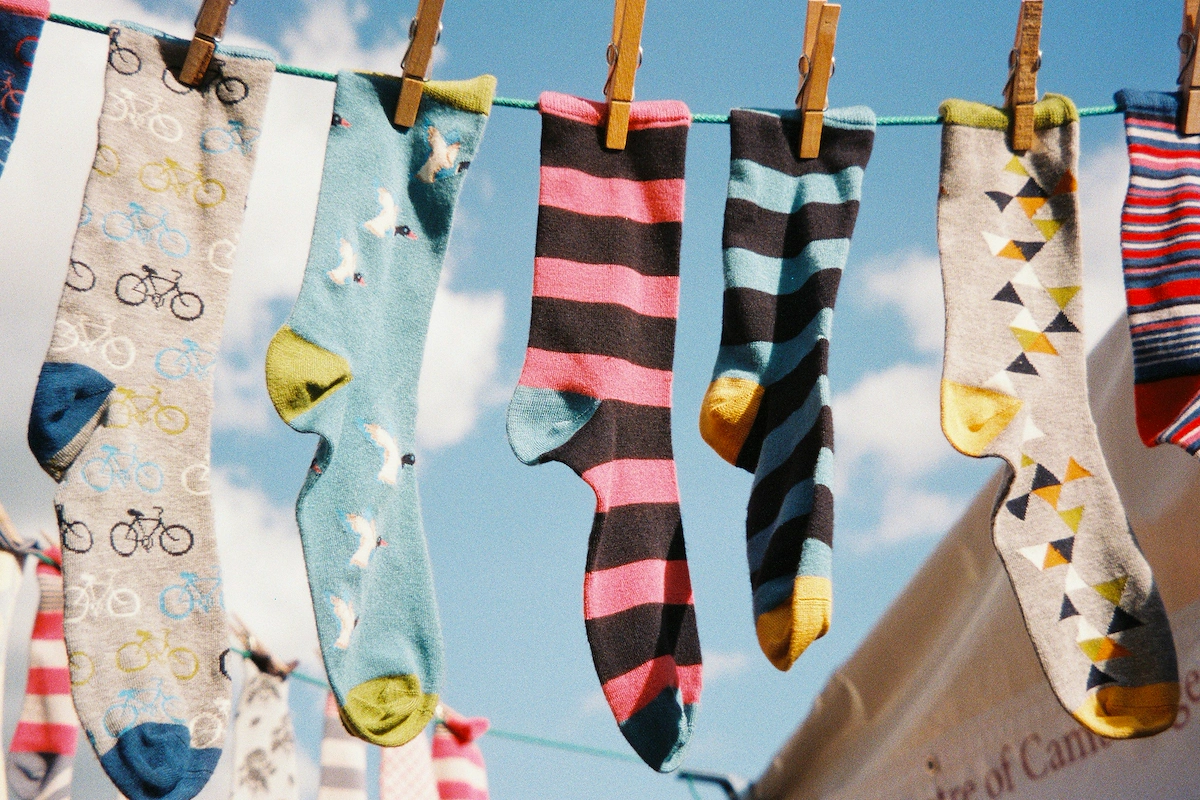Starting a sock business is an exciting venture that combines creativity with business savvy. The global sock market is a multi-billion dollar industry, driven by steady demand for everything from athletic performance socks and formal dress socks to fun, novelty designs.
This guide will take you through the practical steps of validating your business concept, building supplier relationships, acquiring inventory, and obtaining the right licenses to help you launch a successful sock business in the U.S.
Step 1: Validate your sock business concept
Before you spend a dollar, define your target customer. Use Google Trends to compare search interest for niches like 'bamboo socks' versus 'graphic socks'. A frequent misstep is to create socks for everyone, which makes marketing difficult and expensive.
Analyze your competition
Examine what successful brands do. You can use platforms like Ahrefs to see their popular pages and keywords. Also, browse Etsy and Amazon for top-selling sock designs. Note their prices, materials, and customer reviews to find gaps in the market.
Estimate your startup costs
Your initial investment will vary, but a solid budget is key. Plan for inventory costs of about $2-$5 per pair for an initial order of 100-200 pairs per design. This could be $200-$1,000 for your first style.
Add costs for business formation ($50-$500 for an LLC) and an e-commerce site like Shopify (around $39/month). A small marketing budget of $300-$500 is also a good idea. Your total startup fund might range from $1,500 to $5,000.
Here are 4 immediate steps to take
- Define three potential customer niches for your brand.
- List five direct competitors and analyze their pricing.
- Create a startup budget spreadsheet with estimated costs.
- Use Google Trends to compare search volume for your top three sock ideas.
Step 2: Set up your legal structure and get licensed
Your next move is to formalize the business. A Limited Liability Company (LLC) is often the best fit. It protects your personal assets, like your home and car, from business debts. This is a major benefit compared to operating as a sole proprietor.
You can form an LLC through your state's Secretary of State website. The filing fee typically ranges from $50 to $500. Once registered, open a separate business bank account. Many new owners make the mistake of mixing personal and business funds, which can remove your liability protection.
Secure your licenses and permits
First, get a free Employer Identification Number (EIN) from the IRS website. You will need this for taxes and banking. Next, apply for a state seller's permit, also called a resale license. This allows you to buy wholesale inventory without paying sales tax and to collect it from customers.
Suppliers will almost always ask for your seller's permit before they work with you. Finally, check with your city or county clerk for a general business license. These usually cost between $50 and $100 per year. Processing times can range from a day to several weeks.
Understand labeling rules
The U.S. Consumer Product Safety Commission (CPSC) enforces labeling laws under the Textile Fiber Products Identification Act. Your socks must have a label stating the fiber content, country of origin, and your business name or RN number. This information must be accurate.
Here are 4 immediate steps to take
- Register your LLC with your state's Secretary of State.
- Apply for a free Employer Identification Number (EIN) online with the IRS.
- Obtain a seller's permit from your state's department of revenue.
- Review the CPSC's textile labeling requirements for your products.
Step 3: Protect your business with the right insurance
With your legal structure in place, the next step is to manage risk. General liability insurance is your baseline, but for a sock business, product liability is equally important. It protects you if a customer claims your product caused them harm, like an allergic reaction.
Find your policy
A Business Owner's Policy (BOP) is a good starting point. It bundles general liability with commercial property insurance, which protects your inventory from theft or damage. Expect to pay $500 to $1,200 annually for a policy with $1 million in liability coverage.
When you request quotes, consider providers that focus on e-commerce. Companies like Hiscox, Next Insurance, and The Hartford understand the landscape. An agent who specializes in small business can also help you compare rates and coverage details effectively.
Address sock-specific risks
Many new owners assume general liability covers product issues, but it often does not. You need to confirm your policy has explicit product liability coverage. This protects you from claims related to material defects, dyes, or other issues that could cause injury.
Here are 3 immediate steps to take
- Request quotes from at least two e-commerce insurance providers.
- Confirm with an agent that your policy includes product liability coverage.
- Calculate your inventory's value to get the right amount of property coverage.
Step 4: Find a manufacturer and source your materials
Choose your manufacturing partner
Your search for a manufacturer can start on platforms like Alibaba for overseas options or Maker's Row for U.S.-based factories. Expect a Minimum Order Quantity (MOQ) of 100-300 pairs per design. This number is a key factor in your initial inventory cost.
Always order a physical sample before you commit to a full production run. A frequent misstep is skipping this to save time, only to receive an order of hundreds of pairs with the wrong color or a poor fit. Production itself can take 4-8 weeks, not including shipping.
Select your materials and workspace
The material you choose should match your target customer. Combed cotton works well for everyday designs, while merino wool is great for performance socks. Your manufacturer can provide options and pricing based on your choice.
You do not need a large commercial space at first. A clean, dry area in your home or a small 5'x5' storage unit is enough for inventory. You will need a shipping scale ($20-$40), a thermal label printer ($100-$250), and packing supplies.
Here are 4 immediate steps to take
- Request quotes and samples from three potential manufacturers.
- Decide on the primary material for your first sock design.
- List the shipping equipment you need and create a budget for it.
- Contact two factories to confirm their MOQs and production timelines.
Step 5: Set up your payment systems
Your e-commerce platform, like Shopify, will have a built-in payment processor such as Shopify Payments. These systems accept all major credit cards automatically. The setup usually involves connecting your business bank account and verifying your identity. It takes just a few minutes.
Pay attention to transaction fees, which are typically 2.5% to 3.5% plus a small fixed fee per sale. A common mistake is to overlook these costs, which can eat into your profit margins. Factor these percentages into your sock pricing from day one.
Accept payments anywhere
For selling at markets or pop-ups, you need a flexible way to take payments. For sock businesses that need to accept payments on-site or on-the-go, JIM offers a streamlined solution. With JIM, you can accept debit, credit and digital wallets directly through your smartphone - just tap and done.
At just 1.99% per transaction with no hidden costs or extra hardware needed, it's particularly useful for selling at craft fairs. This rate is often lower than the average commissions other payment solutions offer. The process is straightforward.
- Get Started: Download JIM app for iOS
- Make a Sale: Type the sales amount, hit sell, and ask your customer to tap their card or device on your phone
- Access Funds: Your money is available right on your JIM card as soon as the sale is done - no waiting for bank transfers
Here are 3 immediate steps to take
- Compare the transaction fees for your e-commerce platform's default payment processor.
- Identify two local markets or pop-up events where you could sell in person.
- Download the JIM app to see how it works for in-person sales.
Step 6: Secure your funding and manage finances
Most sock businesses are self-funded, but you have options. An SBA Microloan can provide up to $50,000, with an average loan around $13,000. Interest rates are typically between 8% and 13%. A business credit card with a 0% introductory APR is also useful for initial inventory buys.
Plan your working capital
You will need cash on hand for the first six months. Budget for at least two inventory reorders, which could be $1,000-$2,000. Also, set aside $300-$500 per month for marketing and your e-commerce platform fees. This totals about $3,000-$6,000 in working capital.
Many new owners get caught without cash when a popular design sells out. To avoid this, track your profit margin on each sock style. Use a simple spreadsheet to subtract your cost per pair, transaction fees, and shipping from your sale price. This tells you which designs fund your growth.
In addition to loans, look for grants. The Amber Grant awards $10,000 monthly to women-owned businesses. The NASE Growth Grant offers up to $4,000. These are competitive but do not require repayment, which is a huge advantage.
Here are 4 immediate steps to take
- Research the requirements for an SBA Microloan in your state.
- Create a six-month working capital budget in a spreadsheet.
- Identify one business grant program and note its application deadline.
- Compare two business credit cards with 0% introductory APR offers.
Step 7: Hire your team and set up operations
You will likely handle everything yourself at first. Consider your first hire when you spend more than 10-15 hours per week on fulfillment. This frees you to focus on marketing and product development, which are the real growth drivers for your business.
Your first hires
A part-time Fulfillment Associate is a great first step. This person packs and ships orders and manages inventory. Expect to pay $15-$20 per hour. A frequent misstep is to hire without clear instructions. Create a simple one-page guide on your packing process before they start.
You might also consider a Virtual Assistant (VA) for customer service emails or social media tasks. You can find VAs on platforms like Upwork for $20-$35 per hour. This keeps you from getting bogged down in administrative work as your sales grow.
For team communication and task management, a simple setup with Slack and Trello works well. You can create channels for orders, marketing, and customer questions. This keeps everyone aligned without the need for complex software at the start.
Here are 4 immediate steps to take
- Track the hours you spend on fulfillment for one week.
- Write a one-page job description for a part-time Fulfillment Associate.
- Research two virtual assistant platforms like Upwork or Fiverr.
- Create a simple workflow for your order fulfillment process.
Step 8: Market your socks and acquire customers
Use targeted social media ads
Start with Meta ads on Facebook and Instagram. You can begin with a daily budget of $15-$25. Target users based on specific interests that match your sock niche, such as "marathon runners" for athletic socks or "sustainable fashion" for eco-friendly designs.
A frequent mistake is to spend without a clear goal. Aim for a Customer Acquisition Cost (CAC) under $20. If you spend $100 on ads and get five new customers, your CAC is $20. This metric helps you know if your ads are profitable.
Work with content creators
Collaborate with micro-influencers who have 10,000 to 50,000 followers on Instagram or TikTok. Many will promote your socks in exchange for free products. This approach often builds more trust than a direct ad. You can find them by searching relevant hashtags.
Think about your brand's story. Bombas, for example, built its entire marketing strategy around its "one pair purchased, one pair donated" mission. A strong social angle or unique brand story can be your most powerful marketing asset and set you apart from competitors.
Here are 4 immediate steps to take
- Draft a Meta ad campaign targeting one specific customer interest.
- Calculate your target Customer Acquisition Cost (CAC) based on your pricing.
- Identify five micro-influencers who align with your brand's values.
- Outline a unique marketing message or social mission for your brand.
Step 9: Price your socks for profit
First, calculate your Cost of Goods Sold (COGS). This is your per-pair cost from the manufacturer, plus any shipping and import fees. A typical COGS for a quality pair of custom socks is $2-$4. This number is the foundation for your entire pricing strategy.
Set your markup
A good starting point is to price your socks at 3x to 4x your COGS. For example, if your COGS is $3, a retail price between $9 and $12 is a solid target. This provides a healthy gross profit margin of 66% to 75%.
That margin is not all profit. It needs to cover your marketing costs, e-commerce platform fees, and other overhead. Many new owners price too low and find they have no money left for growth. Setting a strong initial markup prevents this cash flow trap.
With a target price in mind, see how it compares to competitors on Etsy and Shopify. Look beyond the price tag. If your quality or design is superior, you can price at the higher end of the market. Do not feel you have to be the cheapest to make sales.
Here are 4 immediate steps to take
- Calculate your total COGS for one pair of socks, including all fees.
- Set a target retail price using a 3x to 4x markup on your COGS.
- Research five competitors to compare your target price against their offerings.
- Calculate your gross profit margin based on your final price.
Step 10: Control quality and scale your business
For every new shipment, inspect at least 5-10% of the socks. Create a checklist to look for loose threads, inconsistent sizing, and color bleeding. A frequent mistake is to trust the factory completely, which can lead to shipping defective products and damaging your brand's reputation.
Set your quality standards
Ask your manufacturer if their materials are OEKO-TEX STANDARD 100 certified. This ensures the textiles are free from harmful substances. For your own metrics, aim for a defect rate below 2% per batch. If you find more, you have a solid basis to request a credit from your supplier.
Once your quality is consistent, you can focus on growth. When you spend more than 10-15 hours a week packing orders, it is time to hire a part-time fulfillment associate. This frees you up to work on marketing and product development, which actually grow the business.
As you add more designs or sell on multiple platforms like Amazon and Etsy, consider an inventory management system. Software like Cin7 or Skubana syncs your stock levels automatically. This prevents you from selling an item that is out of stock, a common issue as businesses scale.
Here are 4 immediate steps to take
- Create a quality inspection checklist for your next inventory shipment.
- Ask your manufacturer if they have OEKO-TEX certified materials.
- Set a weekly order volume (e.g., 50 orders) as your trigger to hire help.
- Research an inventory management system for when you expand your product line.
Starting a sock business is about more than just fabric and thread. Your brand's story is what will connect with customers and set you apart. Remember that a great design with a clear message can turn a simple product into a statement. You have the roadmap, now go build it.
And when you make those first sales, payment should be simple. A solution like JIM turns your smartphone into a card reader, so you can accept payments anywhere with no extra hardware for a flat 1.99% fee. Download JIM and get ready for your first customer.















